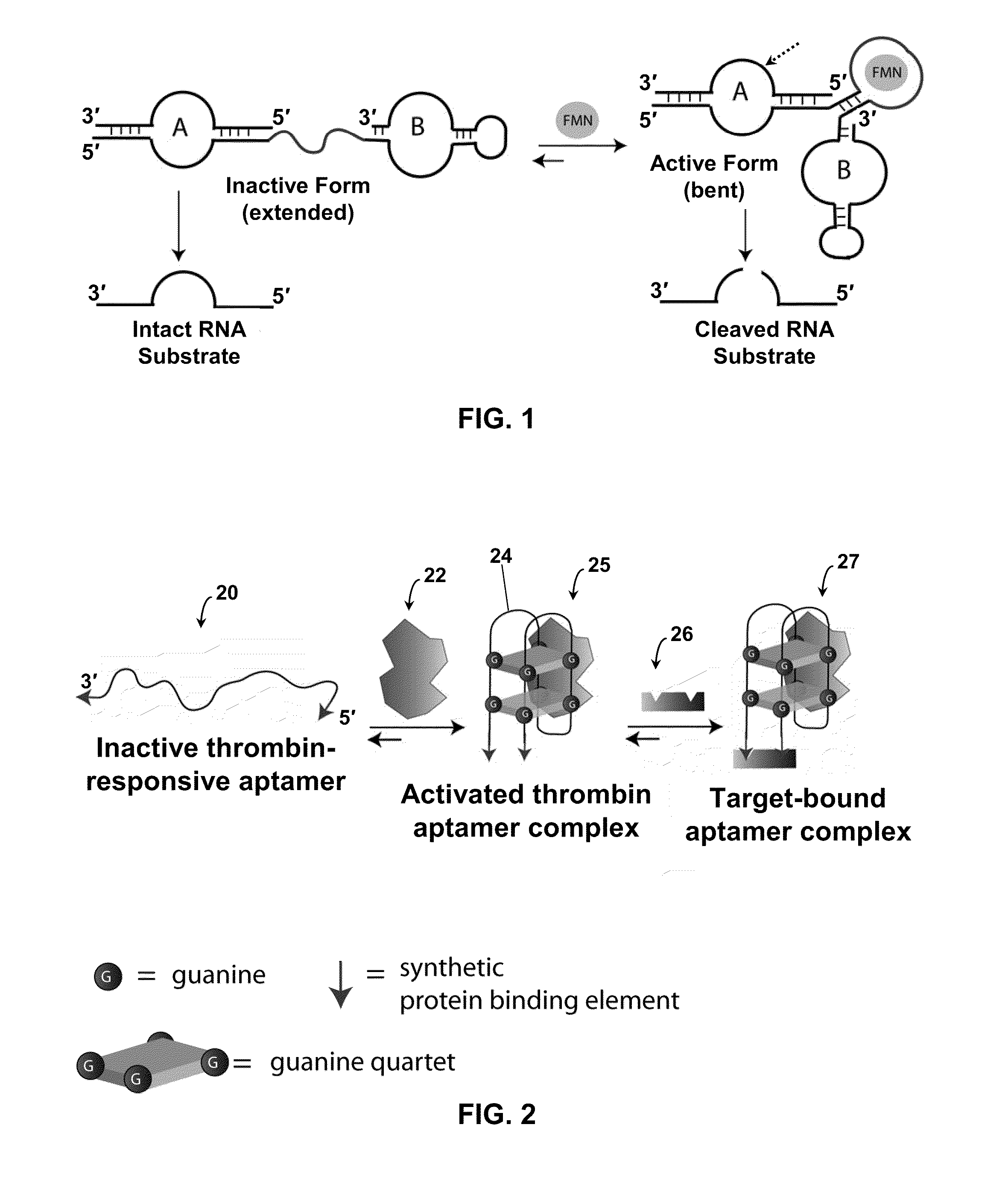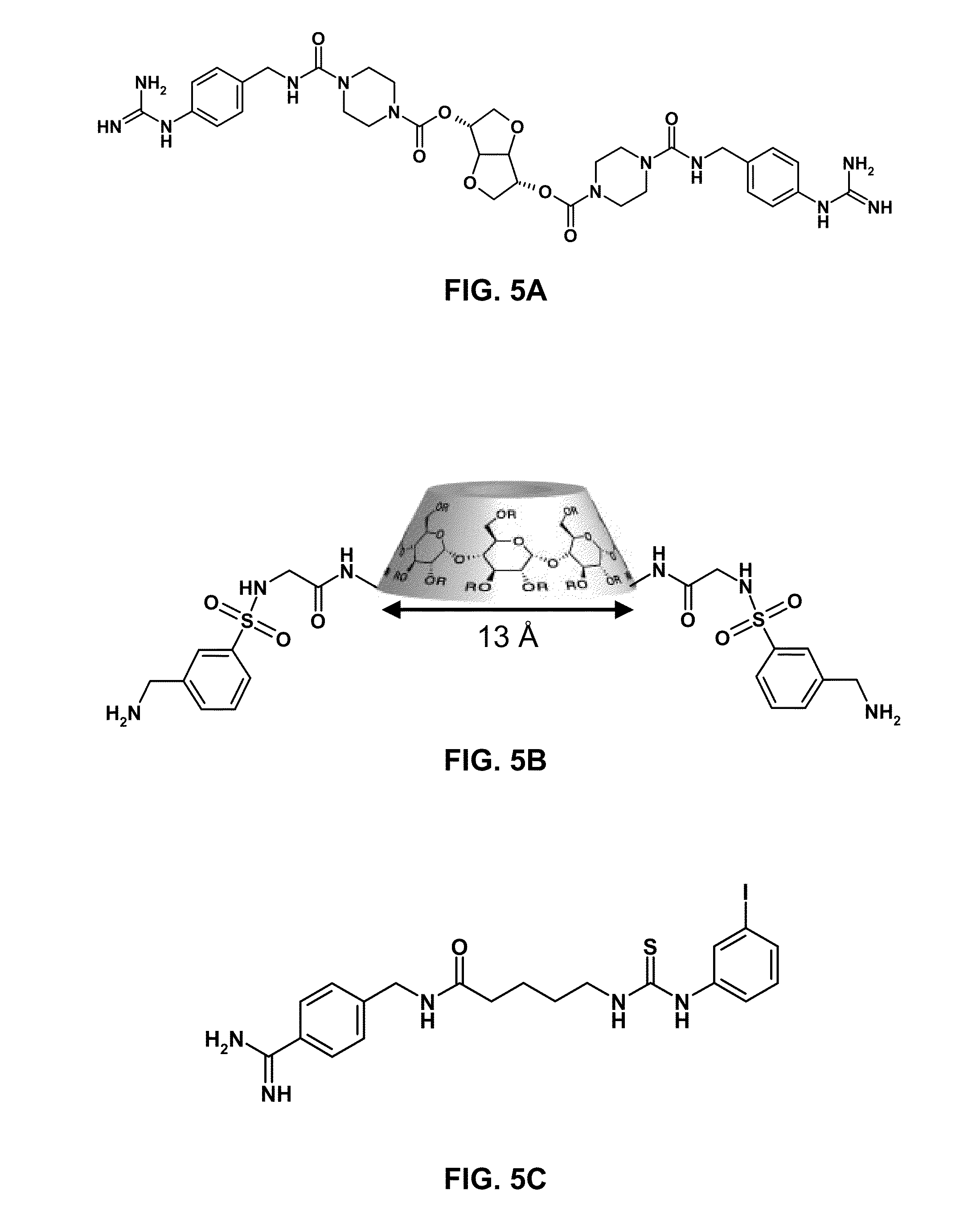Stimulus-responsive apta chelamers
a chelamer and stimulus-responsive technology, applied in the field of chemical and molecular biology, can solve the problems of limited success, serious side effects, and inability to selectively inhibit only thrombin and trypsin and not inhibit other members of the serine-protease family, and achieve enhanced thrombin binding, enhanced trypsin binding, and easy deactivation or significantly attenuation
- Summary
- Abstract
- Description
- Claims
- Application Information
AI Technical Summary
Benefits of technology
Problems solved by technology
Method used
Image
Examples
example 1
Design of Apta-Chelamers and of Trypsin-Binding Arms
[0090]Apta-chelamer 1 (FIG. 12, Formula 3) comprises a core aptamer domain derived from the thrombin-binding aptamer sequence (SEQ ID NO:6) and, as such, is capable of forming a chair-type intramolecular quadruplex in the presence of thrombin (see Q. Wu, M. Tsiang, J. E. Sadler, J. Biol. Chem. 1992, 267, 24408-24412; and E. Baldrich, C. K. O'Sullivan. Anal. Biochem. 2005, 341, 194-197, each of which is incorporated by reference herein in its entirety) or templating potassium cations (see S, Nagatoishi, Y. Tanaka, K. Tsumoto. Biochem. Bioph. Res. Corn. 2007, 352, 812-817, incorporated by reference herein in its entirety). In this AC, one deoxythymidine (dT) is added to the 3′ end of SEQ ID NO:6, and two are added to the 5′ end (FIG. 12, Formula 3), yielding SEQ ID NO:1. The terminal 5′-dT is functionalized with fluorescein. The fluorescein fluorophore serves as a spectroscopic marker to study trypsin-binding through fluorescence ani...
example 2
Apta-Chelamer Preparation
[0095]Apta-chelamer 1 was prepared by a simple two-step procedure (FIG. 7). Briefly, the core aptamer sequence (SEQ ID NO:1) bearing a C10-spacer tethered to an N-hydroxysuccinimidyl ester on the 5′-terminus and a C6-spacer linked to a phthalimide-protected amine on the 3′-terminus (which was attached to a controlled pore glass bead) (8; alternatively “ODN 8”) was reacted with 4-aminomethyl benzamidine under basic conditions. The crude 5′-reacted product was cleaved from the bead, and globally deprotected using aqueous ammonium hydroxide. This deprotection step also served to cleave the phthalimide protecting group on the 3′-terminus, thus exposing a nascent primary amine (10; alternatively “ODN 10”). The 3′-terminus was then reacted with 3-iodophenylisothiocyanate to yield AC 1 (1; Formula 3). In addition to synthesizing AC 1, the present inventor also prepared a series of control ODNs (2-4) that lack one or both of the synthetic protein-binding arms. Speci...
example 3
Synthesis of AC 1: 5′-benzamidine Arm
[0098]As represented by FIG. 7, a solution of 5 mg of 4-aminomethyl benzamidine, 1 mL anhydrous DMSO, and 50 μL anhydrous DIPEA, was introduced by syringe to a cartridge containing ODN 8 (1.0 μmol scale) tethered to a controlled pore glass (CPG) support. Note: ODN 8 contains a 5′ N-hydroxysuccinimide ester (5′-Carboxy-Modifier C10) and a 3′ phthalimidyl-amino-modifier (3′-PT Amino-Mod C6). The solution containing 4-aminomethyl benzamidine was pushed through the cartridge ten times and then the CPG-linked DNA / 4-aminomethyl benzamidine mixture was agitated for 1 hr. This process was repeated three times. After which, the CPG-linked DNA / 4-aminomethyl benzamidine mixture was agitated overnight. After removal of the solution containing 4-aminomethyl benzamidine, the cartridge was washed with 1 mL aliquots of HPLC grade acetonitrile and dried by introducing argon flow through the cartridge for 1 hr. The 5′-modified crude oligonucleotide was cleaved and...
PUM
| Property | Measurement | Unit |
|---|---|---|
| mass | aaaaa | aaaaa |
| mass | aaaaa | aaaaa |
| pH | aaaaa | aaaaa |
Abstract
Description
Claims
Application Information
 Login to View More
Login to View More - R&D
- Intellectual Property
- Life Sciences
- Materials
- Tech Scout
- Unparalleled Data Quality
- Higher Quality Content
- 60% Fewer Hallucinations
Browse by: Latest US Patents, China's latest patents, Technical Efficacy Thesaurus, Application Domain, Technology Topic, Popular Technical Reports.
© 2025 PatSnap. All rights reserved.Legal|Privacy policy|Modern Slavery Act Transparency Statement|Sitemap|About US| Contact US: help@patsnap.com



